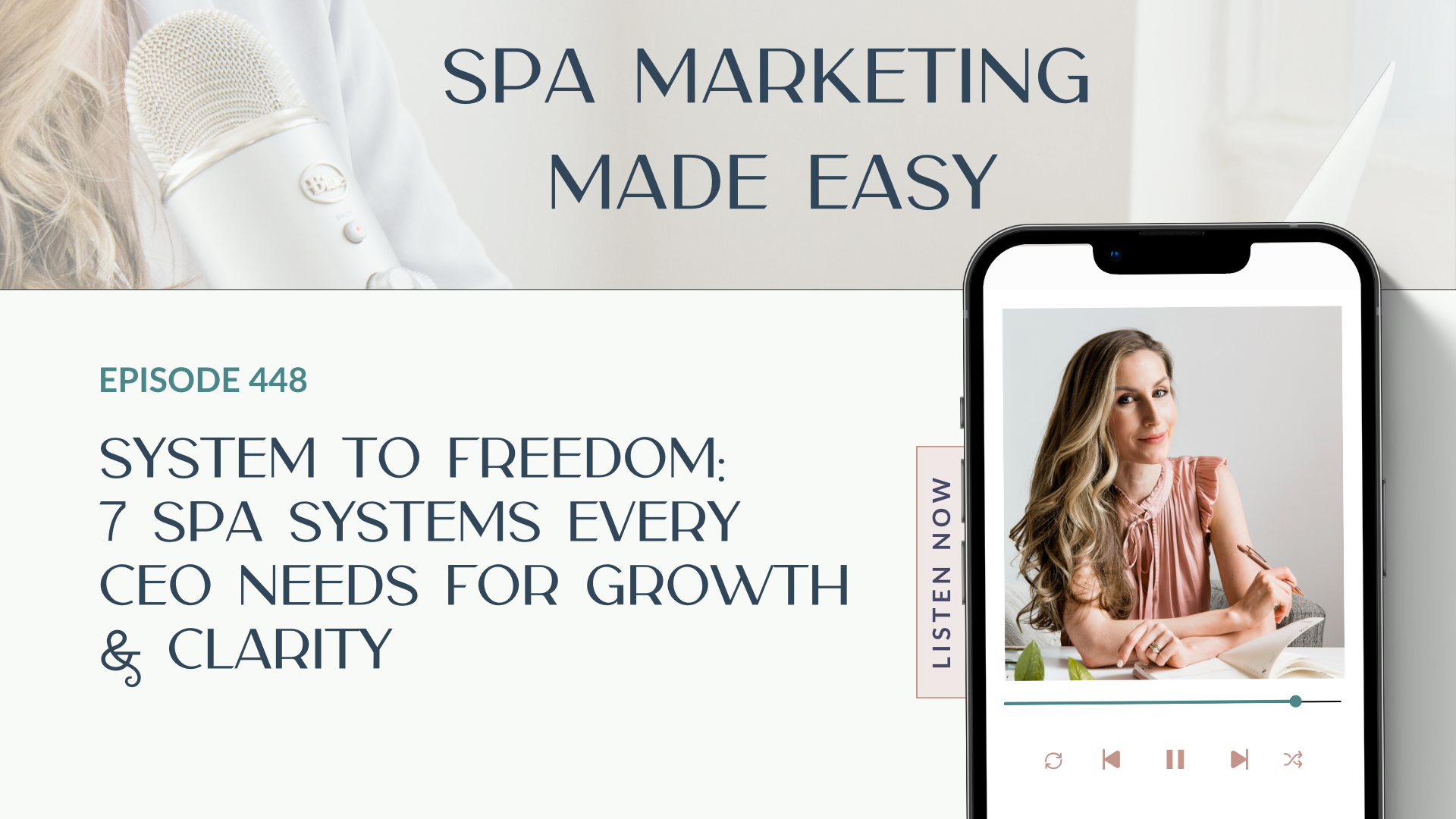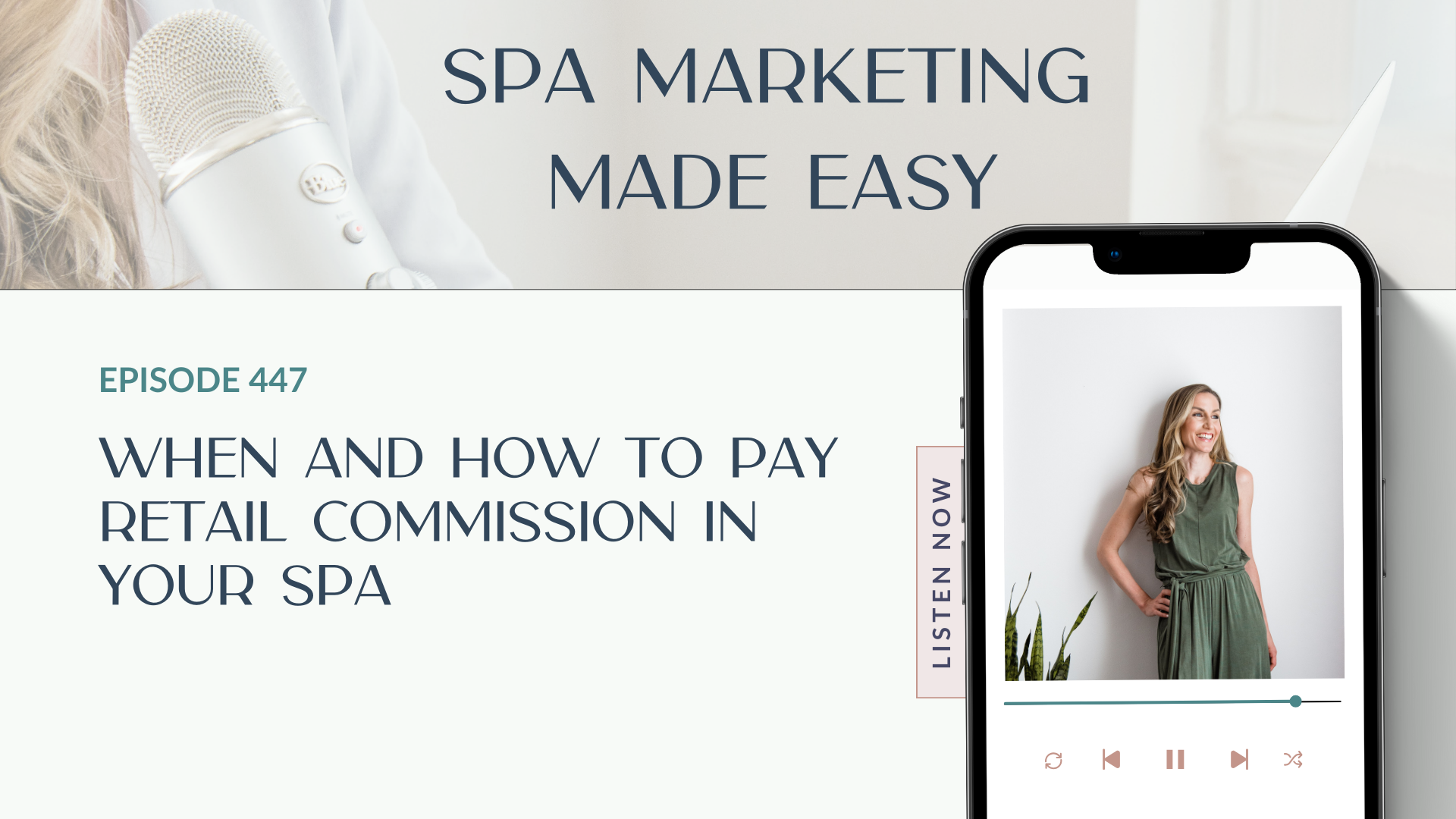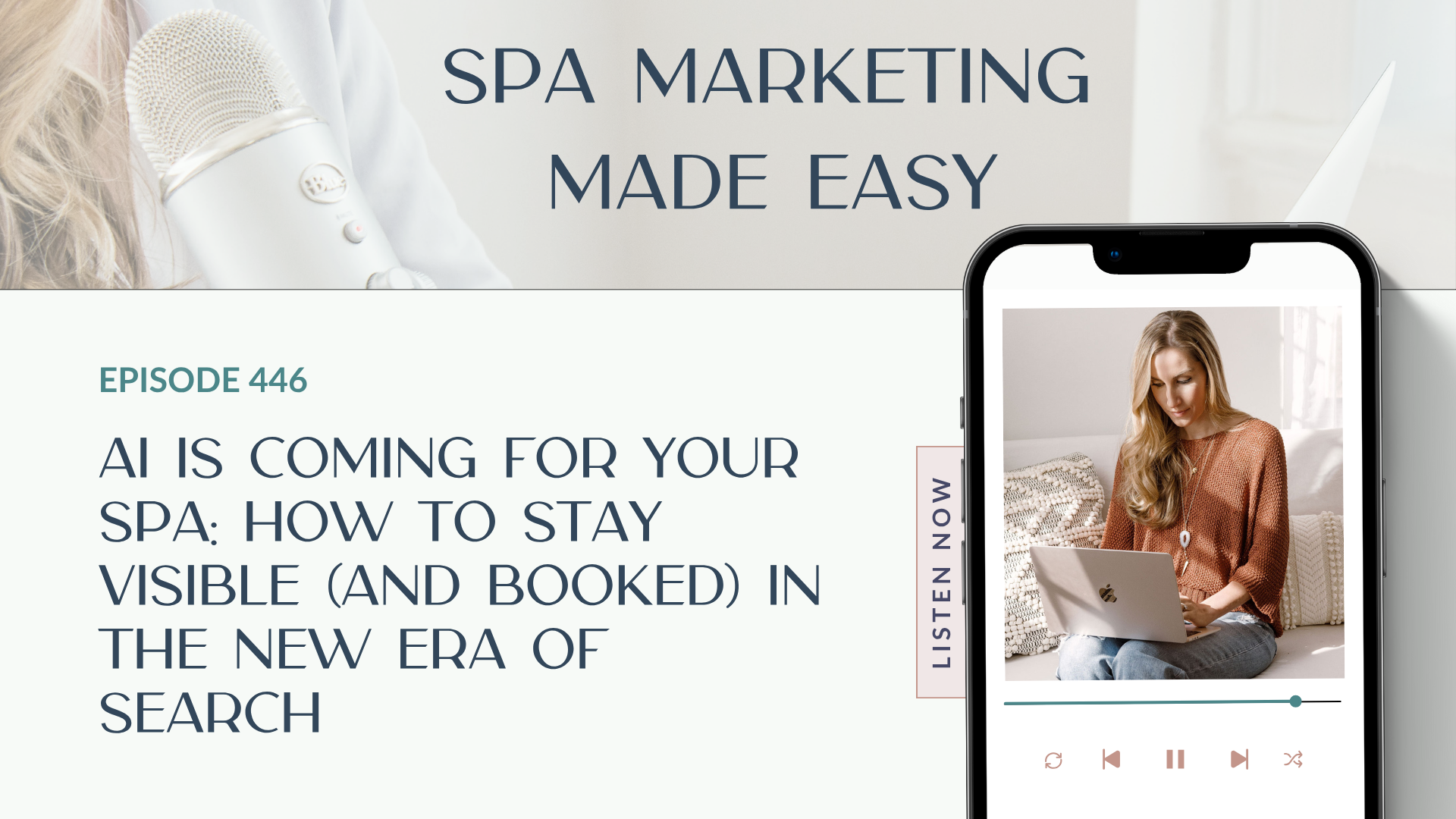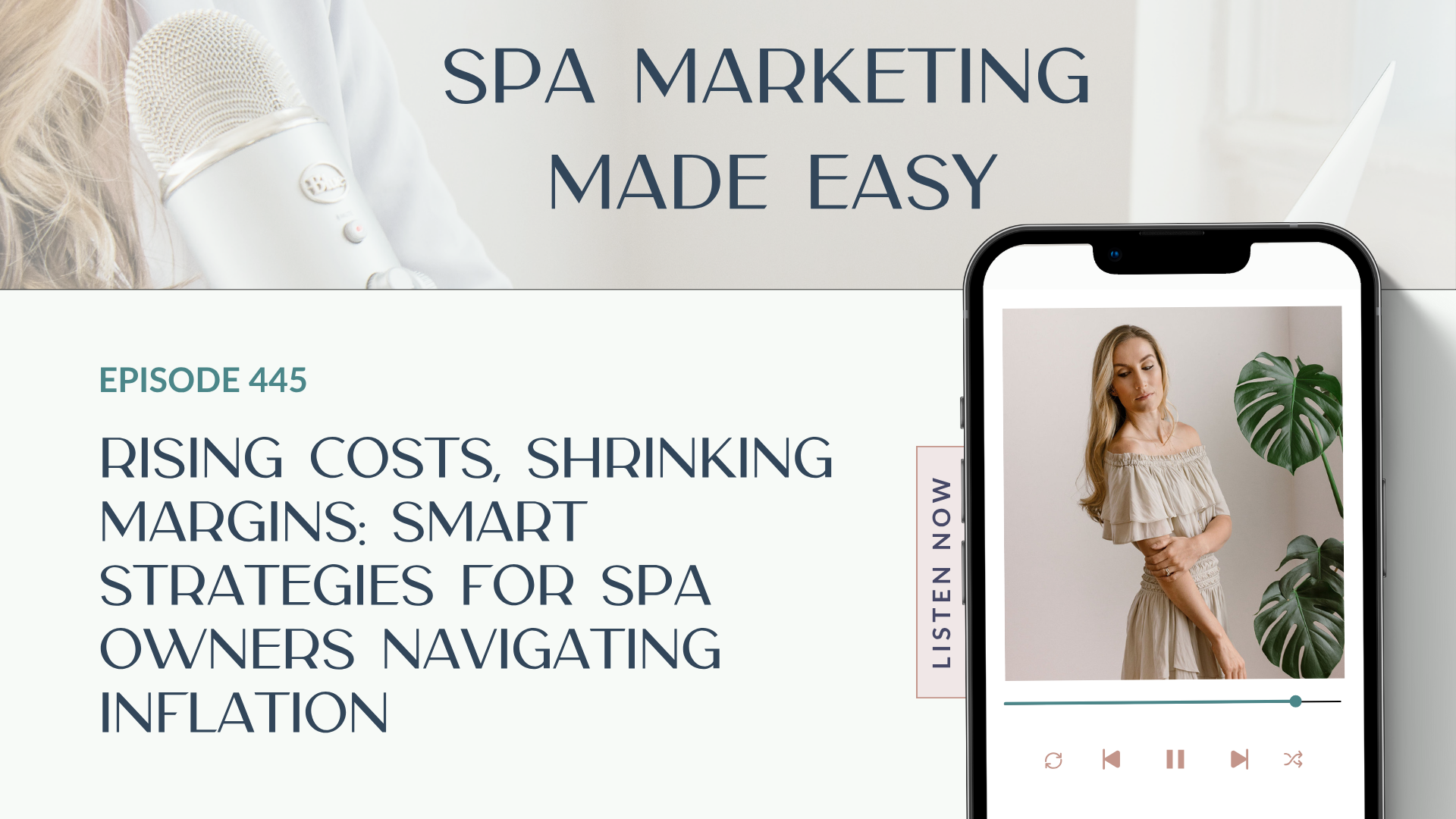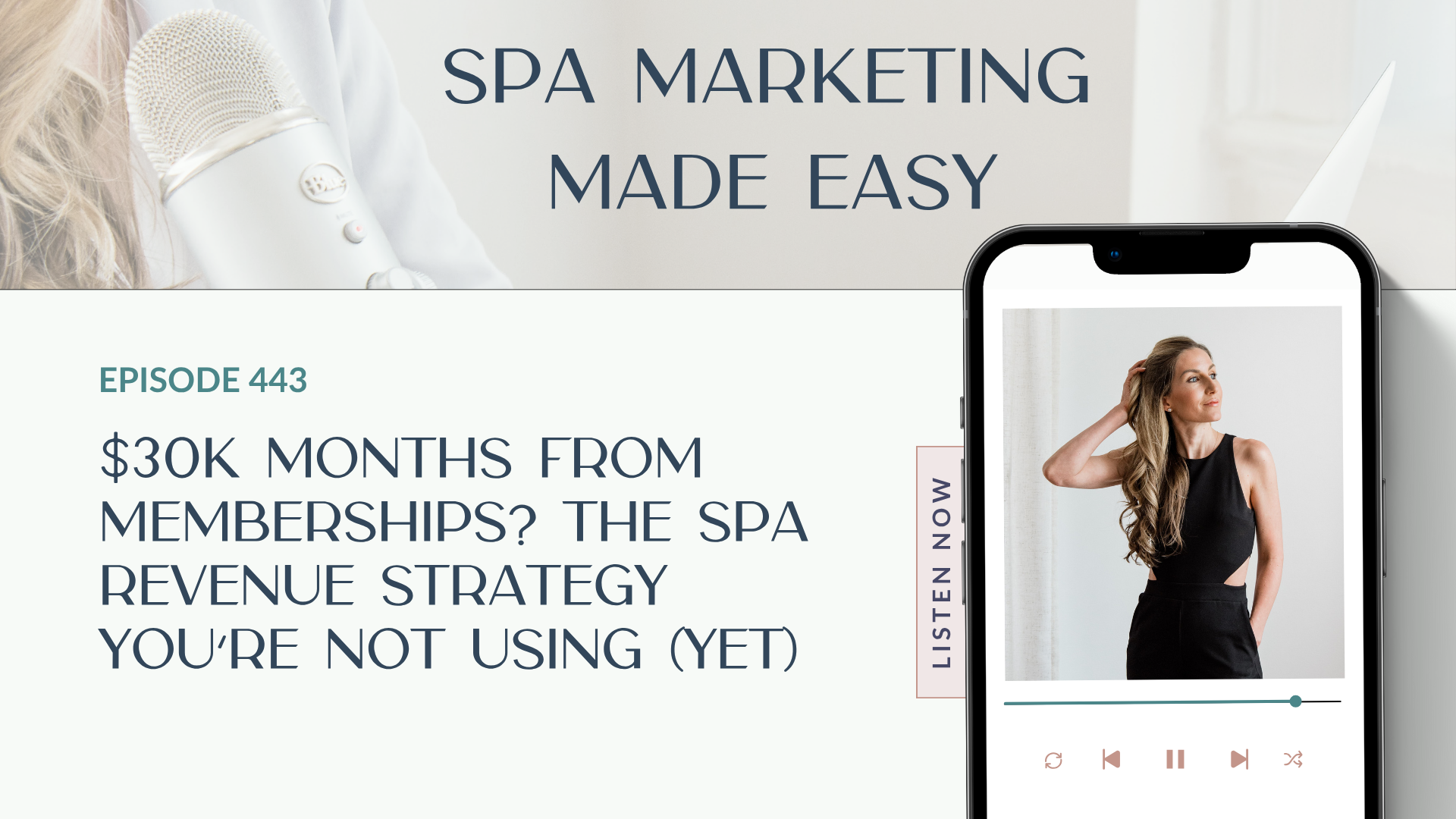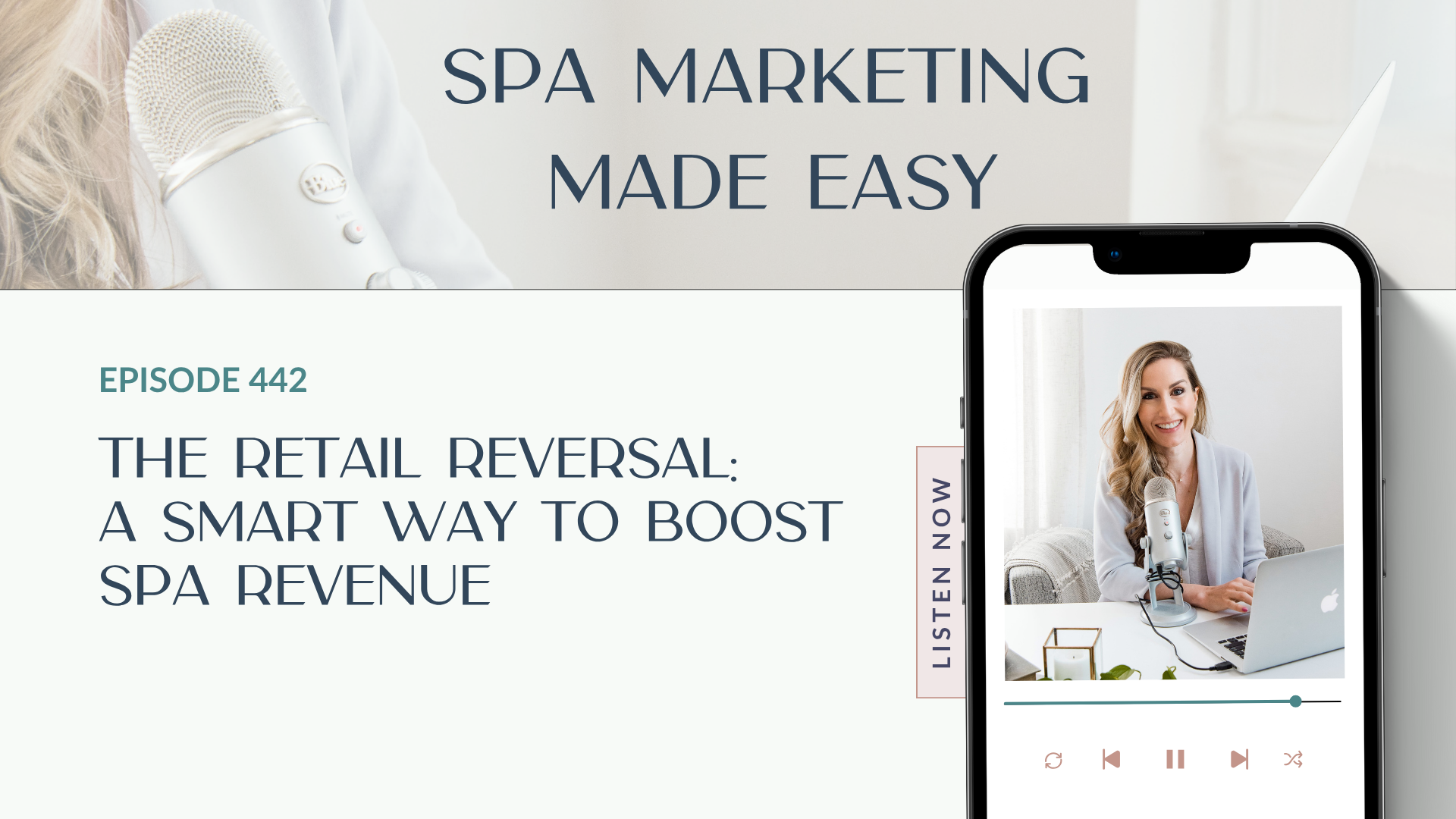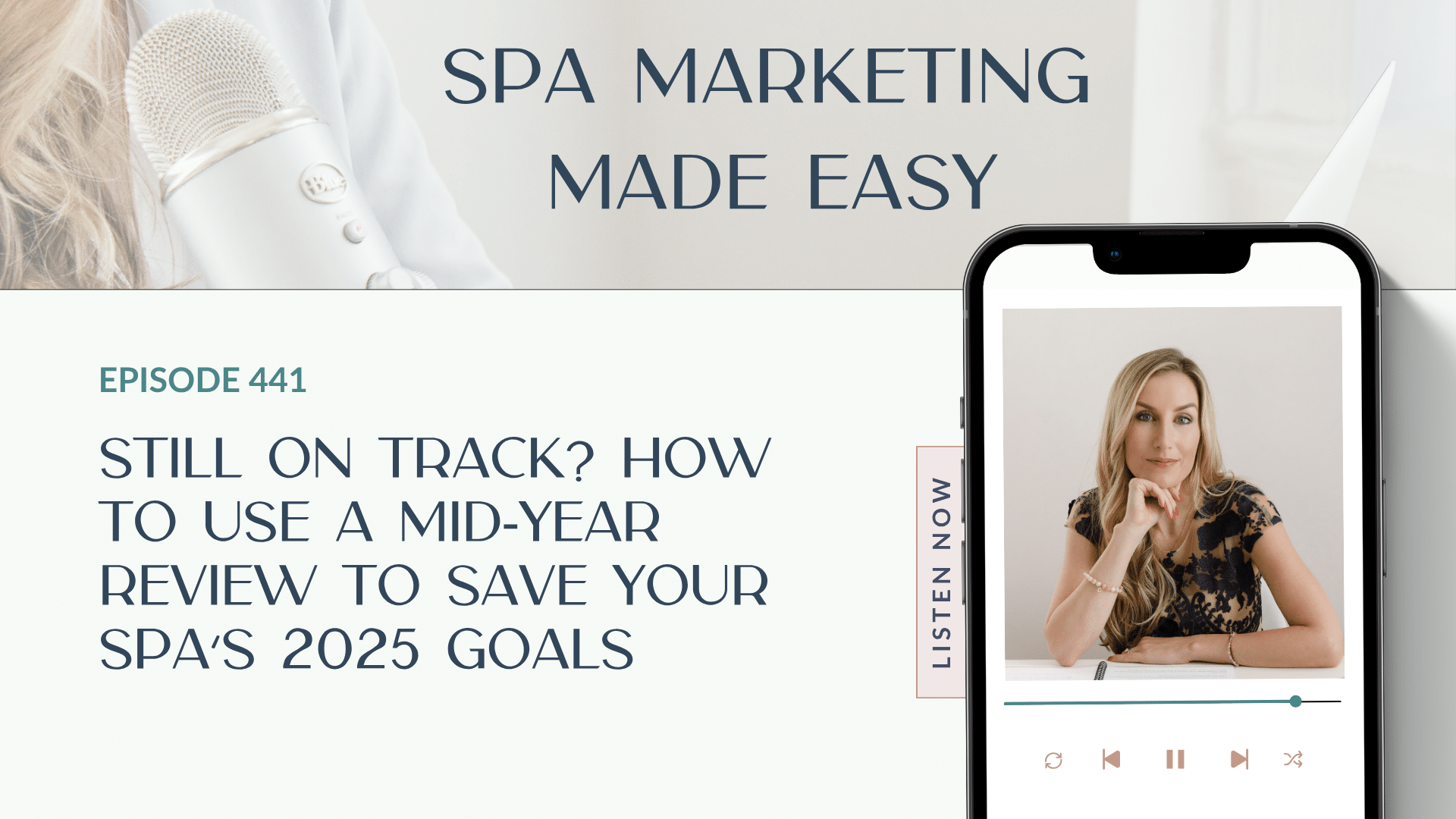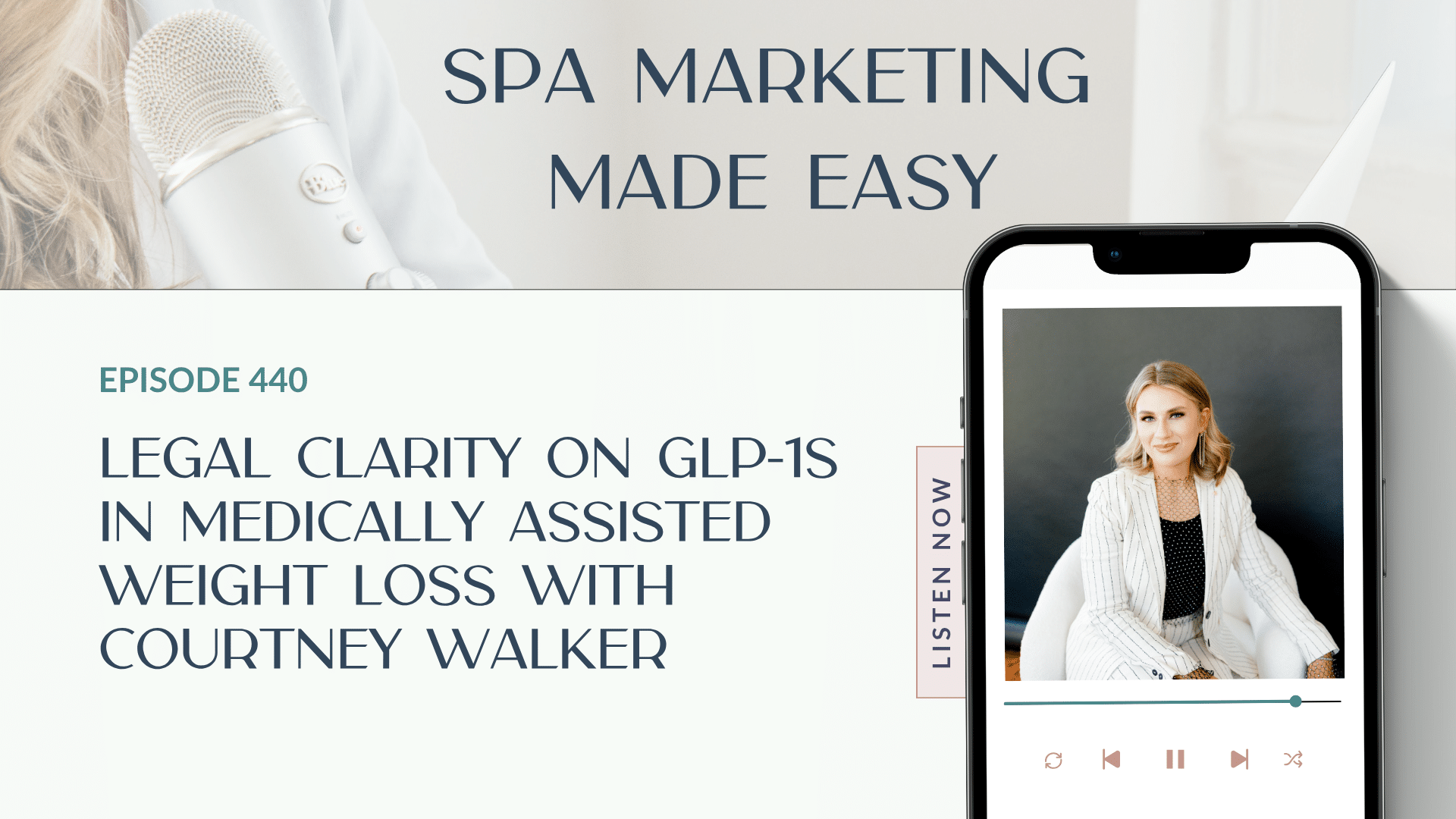Build Systems, Not Stress: The 7 Core Frameworks Every Spa CEO Needs
If your spa feels like a treadmill—always busy yet never growing—you’re in the right place. This episode is a masterclass in building freedom through systems, not software or burnout.
1. Client Journey
Every touchpoint—online to 10th visit—should feel guided, seamless, and thoughtful. Structure appointment confirmations, paperwork, follow-ups, and treatment documentation to build trust and avoid human error.
2. Consultation Process
Create a repeatable, tailored experience using minute-by-minute flows to ensure every consultation is thorough and consistent, no matter who’s performing it.
3. Retail System Integration
Review product recommendation flow charts, reorder systems, and follow-up protocols to make retail feel like care—not sales—and to align it with the client journey.
4. Metrics & KPIs
You can’t manage what you don’t measure. Track revenue, retail, rebooking, marketing performance, and client acquisition cost with dashboards and weekly review systems.
5. Hiring, Onboarding & Development
Use tools like monday.com to standardize hiring steps, onboarding training, and staff development. When you can delegate these processes, you step fully into your CEO role.
6. Marketing & Promotions
Map yearly promotional opportunities (like peel season, holiday promos, or Black Friday) and delegate ownership of tasks so you’re proactive—not scrambling.
7. Financial Management System
Block 30 minutes weekly to review budgets, payroll, profit margins, and revenue flows. Tools like YNAB make cash flow feel manageable and strategic.
Bonus: Annual Planning System
Effective systems evolve. Start building your annual planning processes now—so you can vacation, exercise, or simply lead with vision, not reaction.
Systems aren’t a one-and-done checklist—they’re a way of running everything. Start small, build consistent steps, and watch your spa transform.
Resources Mentioned in Episode #448: System to Freedom: 7 Spa Systems Every CEO Needs for Growth & Clarity
- Never Lose a Customer Again by Joey Coleman

Subscribe to Our Newsletter
Stay up-to-date with our email newsletter to receive important updates, news, and offers!
IG / @addoaesthetics
WEB / addoaesthetics.com
YOUTUBE / @addoaesthetics
LINKEDIN / @addoaesthetics
ABOUT THE SPA MARKETING MADE EASY HOST
About Your Host, Daniela Woerner
Daniela Woerner is the founder and CEO of Addo Aesthetics, a leading community for aesthetic professionals, and the creator of the Growth Factor® Framework—a proven system that has helped 582 six- and seven-figure spa owners scale their businesses with strategy and systems.
With nearly two decades in the aesthetics industry, Daniela has trained alongside top physician-dispensed brands, consulted with leading dermatologists, and helped thousands of spa professionals streamline their operations and maximize profitability.
Her mission? To transform overworked aestheticians into Spa CEOs—building a business and life they love with the strategic systems needed for long-term financial growth.
As the host of the Spa Marketing Made Easy podcast, Daniela brings expert insights, real-world strategies, and in-depth conversations to help spa owners elevate their marketing, optimize their operations, and create sustainable success. With over 400 published episodes, 1 million+ downloads, and a ranking in the top 1% of all podcasts worldwide, Spa Marketing Made Easy is the go-to resource for spa and aesthetic professionals looking to level up.
Tune in each week for actionable strategies, expert interviews, and inspiration to help you build a thriving, systemized, and scalable spa business!
PODCAST TRANSCRIPT:
Welcome back to the Spa Marketing Made Easy podcast, I am your host, Daniela, and today’s episode is covering one of my absolute favorite topics, and that is systems. So why is that my favorite topic? Well, because systems are what create true freedom. It’s not a fancy software, although we may have software incorporated into our systems. It’s not the latest Tiktok trend, and it’s not working yourself into burnout. In fact, it’s quite the opposite. Systems are what allow you to grow. It’s what allows you to step out of the treatment room, it’s what allows you to finally become the spa CEO that your business needs. Systems are what allows you to build a business around the life that you want to live. So today, I’m going to walk you through seven areas of your spa that you can and should systemize if you want less chaos and more clarity. Okay, so let’s get into all of these.
So the first area of your business that we can look at systemizing is your client journey. All right, so this is where it all begins from the time that someone finds you, either online, whether that’s through chatGPT, whether that’s through SEO and search, whether that’s through social, however they are finding you from their first appointment to their 10th visit. We want that entire journey to feel guided. We want them to feel understood. We want them to feel taken care of. So in order to systemize this process, we need to have a clear path like, how do we confirm appointments? What happens when a new client books a service? Are we confirming their appointment? Are we sending them paperwork ahead of time? Are we acknowledging that they’re new when they come in? How are we following up with them? How are our treatment plans documented the entire journey from start to finish should be documented. Okay, so this is going to create consistency in their care. It’s going to build trust, and it’s going to build long term loyalty.
Now, one of my favorite books on the client journey is called Never Lose a Customer Again. It’s by Joey Coleman, and he has an entire framework in side the book that talks about the different stages that a customer goes through in their first 100 days of doing business with you. And he talks about, you know, even further after that. But how are we from the time that they even see who we are and we be, they become aware of our brand, to doing business with us, to the follow up. What does that look like? Now? We’re human, right? We are entrepreneurs. We’ve got a lot of things going on, and it’s very easy and very normal to forget a task, to forget something, even if it’s completely unintentional, which is why we create systems in the first place. They are documented processes around every single aspect of your business to make sure that those steps don’t fall through the cracks, and to also make sure that they’re repeatable no matter who is going through and completing that process.
Okay? So the second part of your business that can be systemized, that can be made very clear, so that we are doing it the same across the board, is your consultation process. Okay? We want every single consultation to feel thorough, customized and clear, but also repeatable, okay, so from the questions that you ask to the treatment recommendation process to how the product recommendations are documented, how you’re showing them to the patient. You know, are we setting them on the counter? Do we have a consultation room? Everything, including the follow up protocol for consultations, this needs to be documented and systemized, very similar to how you would create a protocol for a service.
So minutes one to three, we’re doing this. Minutes three to six, we’re doing this. We want that for the consultation process as well, and that way, when we have a patient that refers somebody else to us, they’re getting that same exact service. And side note here, this is also why it’s incredibly important to have protocols, not only with our consultation system, but with our services. Because if you have one aesthetician who’s not following the timing protocols and is maybe spending going 15 minutes over, spending more time on the massage than she should, and a patient refers, you know another, a friend of theirs, and they go with another aesthetician, and her service was 15 minutes shorter. Or that same patient goes with another aesthetician, just because we’re focusing on being patients of the practice, and then her service is different, she’s going to feel like someone didn’t fully do their job, or didn’t put the same level of effort, like it was shorter, when In fact, it was just one provider who wasn’t following the protocols, so you can see how that can cause so much conflict across the board.
So it’s really important to have these experiences that our patients go through, whether it’s a service or in this case, we’re talking about the consultation, we want it to be systemized across the board, okay, all right.
The third area that should be systemized is your retail system. This is really big, and we actually just did a podcast episode, actually, I think it was last week around your retail like, how and when to pay commission. Part of that episode, we were talking about your product flow chart. So how are we creating consistent recommendations of what and when we’re talking in your entire retail system? How are reorders and follow ups tracked. How is your commission structure based? Is it based on your retail to service ratio? So we want to have everything around retail systemized. So if you haven’t listened to last week’s episode, be sure to check that out. It really goes into the retail commission structure on a much deeper level, that can really help you to systemize this entire process, which actually ties in to the client journey, right?
Because we want to understand how and when are we following up well that aligns with retail sales as well, okay, but to learn how to do your go to product flow chart, which is an incredibly useful tool to help you standardize and systemize your retail recommendations. It’s huge, okay? Number four, the fourth area to systemize in your business is your metrics, okay, you cannot track. You cannot grow what you don’t track. Okay, you can’t manage what you don’t measure. So we’ve got to have a system in place where we are looking at the different KPIs in our best in our business. So if we’re systemizing this, do we have our front desk filling out a KPI tracker, or maybe our spa manager? Are you meeting with your spa manager on a weekly basis and reviewing the KPIs and saying, What is this telling us? Remember that your metrics, your numbers, are the language of your business. It’s what your business is telling you about what’s going on, and so what is the system that you have around this? Now for us with numbers, I actually meet with Lucy, who’s my marketing manager. I have a different process for some of the CEO KPIs that I’m looking at, but for marketing, which I think every single one of you is going to it’s going to be very important for you want to know, like, what are the marketing KPIs that we’re looking at? Is it engagement on our social media accounts? Is it the number of email inquiries or phone calls that we get? What are the specific things, and how can we look at that to understand if the actions that we’re taking with social or with our ads or with our SEO are actually getting us an ROI.
If we’re not looking at the numbers, we’re not going to be able to understand that. So we need to make sure that we have a system around our weekly reporting on revenue, on retail, on rebooking. We want to have monthly performance reviews on team members, kind of where are they at? We want to have. The KPIs for our service providers and our front desks, you perhaps want to have dashboards or spreadsheets that can make your data visible. One of the things that we have inside of our growth factor elite program is a client acquisition cost tracker.
And so when we’re looking at how you’re acquiring new clients, whether that’s social, whether that is SEO, whether that’s word of mouth referral, whether that’s strategic partnerships, whether that’s walk in traffic, we want to understand how much money have we invested in that particular venue? And it might be zero and it might be $1,000 a month, but we want to understand what is it costing us to get a new client?
So when we’re looking at, hey, we’re spending $1,000 a month on SEO, but we’re actually getting 20 new clients from social and we’re spending $500 on SEO, or, excuse me, $500 on social, that data by having a system that we’re looking at that that data is helping us to make decisions that, hey, we actually have more clients coming from social, and so we want to invest more money, because it’s going to be much more profitable from that venue from then the other. And it might be vice versa. You may be getting a ton more from SEO, and maybe you’re investing all your money in social, and we want to switch that. Okay, so this is how and why. Having a system around your metrics and tracking is so vitally important, it’s going to help you shift from guessing into leading with clarity. Okay, so number five, the fifth area of your business that you want to systemize is your hiring, onboarding and development process your team. What are they going through.
So we want to have standardization around our job descriptions. We want to have the hiring and interview flow so where we what is the process, from the time that we decide to hire to the time that we do the job posting, how we’re selecting candidates now here at Addo Aesthetics, we have a very clear hiring, onboarding and development process. We use monday.com which is our project management software, to break down into steps, the hiring system, the onboarding system and the development system, okay? And that’s something that makes it repeatable. It makes it easy to follow. It’s got all the appropriate things linked up inside of there. This is how you create an actual system, okay, so if I’m gonna go higher, then I can pull up my hiring template board, I can duplicate it, and I can put the date in there, and I can go through each of the steps I’m following that system so that if I want to go on vacation, let’s say that it’s summer and I have my spa manager going through The hiring process, because I am on a two week vacation at the beach with my kids, then my spa manager is going through and following the exact same process that I would be following.
That’s the freedom there. Okay, that is something that it is absolutely priceless to be able to have your business working and generating revenue when you are not there, okay, when that is happening, and you can step into that role of Spa CEO, the whole the whole game changes. The whole world changes. You’re able to focus on things that were just you weren’t able to have the capacity to focus on them because you were so in the business. Okay, it’s so vitally important to take your time and go through these different areas. Now I’m gonna, I’m gonna take a pause here and just say your systems are never done. Okay, I’m going through.
I’m giving you seven areas to look at to get started. But know that running a systems based business is a lifestyle. This is a lifestyle. This is a choice that you are making, similar to saying I am choosing a healthy lifestyle where I care about my diet and exercise and my you know, I’m exercising four times a week. You can’t just stop. Of exercising it. I mean, you can, but you’re not going to be able to maintain the same benefits as if you were to stay exercising. Okay, same thing with systems. And one of the things that when I’m talking to spa owners about what’s your 90 day goal? What are we focusing on right now? What’s our top priority? Well, in the next 90 days, I wanna have all my systems created. Okay, well, we can go through and maybe we can pick two or three of these seven that we’re going to get the framework on, but we’re still going to need to revise. We’re going to need to refine. We’re going to need to evolve as our business evolves and grows and changes. Okay, you know, we’ve been really focusing on systems, I would say, since 2017 2018 something like that. And every year we’ve got to update something. If we change a software, we have to update it. If we change an offering, we need to update it. There’s so many different things that you just have to say, this is a lifestyle, this is a philosophy or approach in the way that we operate our business. Okay? So to go back to hiring and onboarding and development, one of the biggest challenges when someone comes to our company is team. They can’t find any good people. They can’t find people that want to work, or they find people that want to get paid, you know, $100 an hour to be a part time aesthetician there. I mean, there’s these things that you hear that’s just like, okay, like, how do we resolve this?
Well, we set extremely clear expectations and communication, okay, so from our job descriptions, those are going to be detailed our hiring process, communicating, what we expect in the role, what are the metrics that we are measuring success and and this is where you know, when we get into leadership as a skill, we talk quite a bit about how it’s normal that to go through 234, sometimes even five hires before you find the right person for that.
Every time you’re going through that process, you’re refining your hiring system, your onboarding system, your development system, you’re saying, Oh, this needs to be added in that needs to be added in. This is where I should be following up. This is where I should be checking in. Okay, it’s, I know it’s hard, but this is what’s going to get you to a place where you know exactly what a great fit looks like. You know exactly how to attract and retain your people that align with your core values. If you don’t have a system around hiring, onboarding and development, it’s going to be a huge struggle and an ongoing struggle, okay?
So area number six that you can systemize is your marketing and promotion okay? So we want to understand your monthly promotion calendar. We want to understand your sales funnels. We want to understand who owns what task. We want to understand your social media so marketing doesn’t have to feel like you’re just like flying by the seat of your pants. This is something especially with AI that we can be so clear and so granular and so dialed in around the messaging that we want to create. Now we know that October is peel season, right? There’s a lot of maybe every October you’re doing a shed the dead and a peel party.
We should know the marketing leading up to that. We maybe you know that every Black Friday you do a particular promotion, or you do a Small Business Saturday, there’s pieces of behavior, of information that we’re doing every year. Maybe you do a Christmas in July. We want to map those things out, okay? And this is also, you know, I’m going to give you a bonus section number eight, which is around planning. I’ll tell you after number seven, but planning and having a system around how you do your annual plan is huge. This is how you are able to go on the vacations that you want, that you have time to exercise, that you just have so much clarity in you. Building a business around the life that you want to live. And we’re actually going to get into this later in September. We’re doing next level growth, which is our annual event. We’ve done it every year for several years, where we walk through the entire process of planning your year out and how I do it, how I’ve done it for years, how I’ve refined it.
This is my annual planning system that I have used from doing the calendar audit to, you know, getting clear on what my goals or desires to understanding the season of life that I’m in. And, you know, what, what are my kids requiring of me at this point. So I’m, I’m going through all of that that’s going to help me with my marketing system. When I know that, right? I’m going to know what I’m doing a year in advance, instead of it being October. And I’m like, Oh, wait, should we do a Black Friday promo? It’s already done. You already know it, right? It’s going to save you so much time. So it’s really an important process to have your marketing and promotion system done in advance, and with AI and with chatgpt and so many of these other incredible tools out there, it’s making it easier than ever, easier than ever, and faster than ever. So there’s literally no excuse at this point. Okay, so part number seven, your financial management system. This is a big one, and we often avoid it, right? We avoid because the numbers are scary. We don’t feel like a numbers person. There’s so many heavy emotions that are attached to money and worth, and so we regularly avoid the finances. I have worked with seven figure spa owners who literally have not looked at their finances. It’ll be October, and they have no idea what they what their revenue or expenses are for the year. And I’m like, Okay, we have some work to do, because there’s obviously some blocks that we need to work through, around financial management, around what money means to you, and your money mindset, and all of those things.
But we want to systemize how we are setting and creating revenue goals. We want to systemize our process for budgeting, for payroll, for you know, in budgeting, I’m talking about how much are we spending on our marketing budget? How much are we do? Are we allocating towards for inventory? Are we tracking our profit margin? Do we have goals around our profit percentage, and then what about pay structures and raises based on performance? That kind of goes with the hiring, onboarding and development, but like, do we have a structure around how we’re going to do raises based off of that. Okay, so there’s a lot that goes into it. I actually do my financial I call it my financial system. Every Monday I have 30 minutes of time blocked off. I go through YNAB.
You need a budget. It’s a budgeting software that is very inexpensive. It’s about 100 bucks a year, and it just gives you so much clarity on cash flow. I absolutely love it. And so every Monday I’m going through I’m categorizing those. I’m looking at our revenue that’s come in. I’m looking at our funnels. I’m looking, I’m assigning categories within YNAB, you know, making sure that they’re tagged appropriately, and just getting comfortable with the numbers and seeing where we’re at. Because if you again, if you’re not measuring it, you can’t manage it all right, when your numbers are organized, you sleep better at night and you make smarter CEO decisions. You know what to focus on when. Okay, so let me just do a recap. Here.
We talked about the client journey. Definitely grab Joey Coleman’s book, great book, never lose a customer again. We talked about your consultation process, that one’s big, right? Because once we’re if we’re spending our marketing dollars and and all of that, to get people into a consultation, we want to make sure that we have that dialed in our retail sales. We want a clear message across the board our metrics and tracking. This is just overall the health of our business, our hiring, onboarding and development. How are we ensuring that we have a healthy and productive team, our marketing and promotions and financial management, and then the bonus one, your annual plan? Planning.
How are you kind of putting all these together and setting the goals that you have for yourself in a clear, easy to understand plan? Okay, the important thing to remember is that you don’t have to complete all of these systems in one day. You can just start and say, You know what, every day I’m going to film one SOP, and eventually I’m going to have enough SOPs on a particular topic that I can put them into a system,and I would just pick one area. Is it the client journey? Is it the consultation? Is it your marketing and promotions stay in that category and really look through, how do I create SOPs and compile them together into a process that creates a system for my business, because without systems, you’re stuck in the weeds.
Okay? You’ll end up resenting your business. You’ll end up getting burnt out. But with systems, with systems, you lead, you get time back, you get breathing room, and that gets you more creative, and that helps you grow your business, which helps you have the ability to pay your team more and impact your team, your community on a greater level. And that’s the goal, right, freedom, flexibility and financial growth. Now, I know I threw a lot at you on this episode, and I know systems are a topic that can kind of make your mind spin a little bit, so if you have questions, please go in the SpaMarketing Made Easy Facebook group, just tag me. We’ve got our team in there. I’m in there. If you have any further questions that you want to talk about from this episode, just let me know. Post them in there, and we are there to support you. Okay, thank you so much for listening, so so much for listening, and I can’t wait to catch you on our next episode.
